
Newsletter of the College of Heralds of An Tir
Volume 2, Number 3 ~ August 28, 2003
September brings new Heirs to An Tir


|
|

|
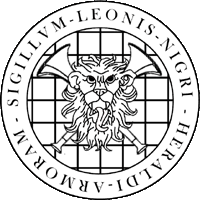
Upon Teceangl stepping down as Lions Blood, Marya Kargashina will be taking the reins from her. The actual changing of the guard will happen at a pace of their own choosing, but I hear its sometime in the next few months.
I would like to the thank Tec for all the amazing work and hours she has put into the job, and to her very capable staff of deputies for supporting her. And I look forward to working with her successor as well.
Please join me in welcoming and supporting Marya in her new position.
Frederic Black Lion
There is a new Dexter Gauntlet - Lord Quentin d'Or, email: dexter-gauntlet@antir.sca.org and a new Argent Scroll (financial deputy) - Darienne de Navarre, email argent-scroll@antir.sca.org
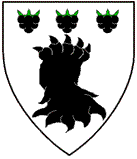
It's always Ithra season. And Ithras are a great opportunity to educate people on the various aspects of heraldry.
Voice heraldry is often a popular subject, and I know there are people out there wanting to learn how to do it properly. I've had several people ask me to teach them town crying, and I've had one new branch herald ask me how to run a Seneschal's Audience.
Device heraldry is a subject that I think most Scadians should take at some point. Preferably before they begin designing their device. This class also attracts new branch heralds and sergeantry candidates and is an important class to have available for both of these categories of people.
If you have the skills and knowledge, and an opportunity becomes available to you, please consider sharing them through Ithra teaching.
It's important to pass along good heraldic habits and help to snuff out myths and poor heraldic practices. You will come away from teaching such classes feeling wonderful for having helped others. I have found, as well, that you learn as you teach, thereby benefiting yourself as well as your students.
Yours in service,
Morel Black Stag
One of the most common errors that I am starting to pick up regarding French name construction is in the area of locative and descriptive surnames.
In the English language, we only have one gender, the Neuter. In French, there are two genders; Masculine (masculin; m) and Feminine (feminine; f). When one constructs a locative byname, special attention and extra research is required to determine the gender of the noun as well as the quantitative quality of the noun, as it will affect the preposition used.
| Preposition: OF | |
| All genders, singular and plural | de |
| Preposition: THE | |
| Masculine, singular | le |
| Feminine, singular | la |
| Masculine, plural | les |
| Feminine, plural | les |
| Combination: OF THE | |
| Masculine, singular | du |
| Feminine, singular | de la |
| Masculine, plural | des |
| Feminine, plural | des |
Here is an example — the client wants the name Michael the Owl as a name, but would like the persona to be French.
Looking up Michael (which we know is a period name through other sources), we discover that the French variant on the name is Michel.
Owl translates to Hiboux, and looking in a French/English dictionary, we find a notation (m) after it, denoting it as a masculine noun.
the translates to le (since we have a masculine noun). In this case, because French grammar does not allow a word that ends in a vowel to be placed in front of a word that starts with a vowel sound (either a vowel or an asprated consonant like an H), we have at this stage Michel l'Hiboux.
SCA heraldry often uses many different kinds of charges. In medieval heraldry, this is unusual. The majority of "core style" heraldry used either one type of charge, or an ordinary and a group of identical charges. If you absolutely must use two kinds of charges (besides ordinaries), make one of them central and another peripheral.
"Core style" heraldry usually uses two or three tinctures. Designs that incorporate four or more tinctures are rare.
Most arms in the Middle Ages and Renaissance consisted of a solid-colored field with one or more charges upon it, each of a solid color. However, a significant minority of arms used a field, or charges, that were divided into more than one color in some fashion. When this was done, the two halves of the field or charge almost always had good contrast. Light colors (like white and yellow) have good contrast with dark colors (red, black, green, blue, and purple). So a field divided into white and blue parts has good contrast between the parts. A field divided in black and blue does not. Fields divided in two parts were much more likely to have high contrast than low contrast in period.
Modern heraldry books list a wide variety of ordinaries and fancy lines of division which often get used in SCA heraldry. Many of them are either unknown or extremely rare in medieval heraldry. The only line treatments that are at all common in medieval heraldry are embattled, wavy, indented, and engrailed. The rest are very late-period inventions. Use medieval line treatments and divisions.
Modern people tend to make designs which incorporate tension. Designs that make the shield look like it's divided into two opposing halves (for example, putting a white moon on black and a gold sun on blue), or which display a number of charges rotating around a central point, are using modern symmetry. The only time tension shows up in "core style" heraldry is when two identical animals are shown facing each other. Otherwise, avoid it.
Heraldry is designed to be easily reproduced by anyone who sees the arms. Thus, heraldic swords are usually drawn like swords, without being specifically identified as claymores, scimitars, or seaxes (for example). A lot of period heraldic art is not sufficiently detailed to distinguish between a deer, a moose, and a caribou. Objects and animals should be relatively generic in appearance.
The number of charges used in "core-style" heraldry was pretty small. Avoid non-western animals and motifs. Remember that many designs found in medieval art were not used in medieval heraldry. If possible, find a book of medieval (not modern) heraldry and see what kinds of charges are used in it. Use medieval charges in your arms.
In "core style" heraldry, charges are usually not arranged so that they touch or cross each other. Avoid designs in which one thing pierces, encircles, or supports another. Each charge should be able to stand on its own.
"Core style" heraldry almost never has upside-down objects or designs. Be careful, because "upside-down" is sometimes different to medieval people. Generally, the "business end" of any item points up. Scallop shells (like the ones on a Shell Gas sign) have the scallop at the bottom. Put your charges right-side-up according to medieval standards.
SCA people often want to include elements from their SCA occupations in their arms--for example, a bard will include a harp, or a fighter a sword. This is done from time to time in period armory (especially by artisans and merchants), but it's much more common in the SCA than in real life. In particular, avoid using an animal that's holding a tool of your trade. Heraldic animals have their own jobs, and don't have time to do yours as well. Maintained charges aren't hugely uncommon in medieval heraldry, but the maintained charges usually weren't occupational in nature.
Name the charges - use their period terms if you can.
Send answers to Lions Blood and answers will be published in the next Heralds' Page.
 |  |  |  |  |
| #1 | #2 | #3 | #4 | #5 |
 |  |  |  |  |
| #6 | #7 | #8 | #9 | #10 |
| Teceangl Bach lions-blood@antir.sca.org tierna@agora.rdrop.com |
August 28, 2003 Send thy comments here: | Brenda Klein 5235 SE Lambert St #A-5 Portland, OR 97206-9068 |
Commentary on this Letter will be due October 10, 2003.
(Send comments to Lions Blood Herald, information at top of this page)
The September Lions Blood meeting will be held on Sunday, September 14th, at the home of Marya Kargashina, 6304 SE 90th Ave., Portland, OR.
Directions from I-205: Take the Foster Rd. exit (number 17) and head toward Portland (left from south, right from north). Get into the left lane immediately and turn left on SE 92nd at the light. Turn right at the second street, SE Tolman and go two blocks. The house is on the corner of 90th and Tolman on the SE side (left). There's a white picket fence and trees in the yard.
Tri-Met public transit: The #14 Hawthorne to Foster & 94th stops 2 blocks away. Leaving Union Station at 12:14 gets you to SE 90th & Woodstock at 12:52pm on Sundays. Walk south 2 blocks, away from Woodstock Blvd., to get to Tolman.
The October Lions Blood meeting date and location are TBA.
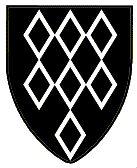
Well, this is it. In a month or perhaps two I will no longer be Lions Blood. Marya has been with me as Boar (the IL deputy) for a year, and has been doing everything she can to learn all facets of the Lions Blood job, up to and including nagging me into showing her the procedures. This, of course, delights me no end, for I know that the kingdom submissions will be in good hands with her. I believe I'll also be on call to assist her as needed, as she has assisted me and as I had assisted our predecessors as Lions Blood. Which will be nice, as I'm not sure I can quit cold turkey.
If anyone's interested, I've been in this job for two years. I've loved it and had a great deal of fun. And I am not going away. I shall remain on Black Lion's staff under the title Ounce as a CoA and internal commenter, and Black Lion has let me know there are some tasks he would perhaps like me to address in the future. And I'll still be delighted to consult with, teach conflict checking or other book heraldry to, or be a resource and aide for any herald who wishes to ask. Heraldry is what I do in the SCA, don't try to stop me!
A primary charge group lies entirely upon the field and occupies the center of the field (and can spread into other areas) OR is the only charge group lying upon the field that is not a peripheral ordinary as defined in X.4.a.i. An orle of charges can be the primary charge group if no charge occupies the center of the field, semy of charges can be the primary charge group if no other charge occupies the center of the field, a single charge in canton can be the primary charge group if no charge occupies the center of the field. A peripheral ordinary as defined in X.4.a.i. can never be a primary charge.
A secondary charge group lies entirely upon the field around or beside the primary charge group. You cannot have a group of secondary charges without having a primary charge group. Peripheral ordinaries accompanying a primary charge group are a secondary charge group. A tertiary charge group lies entirely on another charge, either primary or secondary, or peripheral, and does not touch the field at all.
An overall charge group overlaps charges which lie on the field and touches the field on either side of them. Peripheral ordinaries as defined in X.4.a.i. cannot be overall charges. Charges blazoned with "surmount" in some form are overall charges as well. "A chevron azure surmounted by a sword gules" has a sword as the overall charge.
For a far more complete introduction to charge groups and their use in blazon, read "A Grammar of Blazonry" at http://www.sca.org/heraldry/laurel/bruce.html. If you do not have internet access, please contact me (Teceangl) and I will print and send you a copy of this invaluable document. It is a must-read for all armorists.
Discussion has been raised regarding various details of the Legal Name Allowance, so a clarification is in order. The two main points of discussion are (1) whether or not use of the Legal Name Allowance carries a weirdness, and (2) how the language of the legal name element(s) should be judged. Precedent states:
Beginning with the 5/96 meeting, therefore, use of two individually permissible non-period elements in a single name will be considered two 'weirdnesses' and will be grounds for return. Such elements include non-period names allowed under the Legal Name Allowance as well as those names, apparently not used by human beings in period, that have been declared 'SCA-compatible', e. g., Briana, Ceridwen (in several variants), Gwendolen/Guendolen, R(h)onwen, and Rowena. (Talan Gwynek, Cover Letter to the January 1996 LoAR, pp. 3-4)
Therefore, a name which falls in the category of "non-period names allowed under the Legal Name Allowance" (emphasis added) described in the ruling cited above carries a weirdness.
If the name element can be documented as being used in the submitted position in period, there is no weirdness for use of this name element. As an example, if John is submitted as a masculine given name under the Legal Name Allowance, there is no weirdness for use of this element, because it is documentable as a masculine given name in English in period. On the other hand, if Craig is submitted as a masculine given name under the Legal Name Allowance, there would be a weirdness for use of this element. In this case, Craig would be the submitter's legal given name. While Craig is a commonly accepted masculine given name today, no evidence has been found of it being used as a given name in period. It is registerable as a given name only through the Legal Name Allowance and so carries a weirdness.
In some submissions, multiple elements from the submitter's legal name are used. In these cases, there is only a single weirdness for invoking the Legal Name Allowance, not one weirdness for each element submitted from the submitter's legal name. As an example, a submitter whose legal name contains both a non-period given name and a non-period surname could register [legal given name] [legal surname] of London, because these portions of this name, which use only the Legal Name Allowance as documentation, would only have one weirdness for use of the Legal Name Allowance and so would be registerable.
It is important to note that we have traditionally ignored the language of the legal name element, just as the language of a branch name is traditionally ignored when of [branch name] is used as part of a personal name. The exception, in the case of the Legal Name Allowance, occurs when the legal name element is excessively obtrusive when combined with other elements of the name, as can be seen in the rulings:
While we allow real-world name elements in SCA names without further documentation, this is restricted to cases where "such elements are not excessively obtrusive." Combining a Gaelic Irish given name with what appears to be a non-European surname falls afoul of this restriction. [Ciarmhac Sayenga, 07/00, R-Æthelmearc]
[...] Combining an English given name with a Hindi byname is no less obtrusive. [Margaret Singh, 02/01, R-Outlands]
[...] Combining a Russian given name with a Scots byname is no less obtrusive and so would be returned. [Vaska McCormick, 04/02, R-Calontir]
The combination of a legal name element from one language with elements from a different language in an SCA name will be judged on a case by case basis. Only if the combination is felt to be excessively obtrusive, will the submitted name be returned. The standard of whether or not a name combination is excessively obtrusive is, of necessity, a subjective standard. The best description of this level of obtrusiveness was provided by Bruce, Laurel, in regards to the different topic of joke names:
Intrusively modern names grab the listener by the scruff of the neck and haul him, will he or nill he, back into the 20th Century. A name that, by its very presence, destroys any medieval ambience is not a name we should register. (Porsche Audi, August, 1992, pg. 28)
While joke names are a separate topic from the Legal Name Allowance, the standard described by Bruce is appropriate in this case. If the combination of a legal name element when combined with other elements of the name produces a name that will "grab the listener by the scruff of the neck and haul him, will he or nill he," out of any medieval ambience upon hearing the name, it is not a name we should register.
Master Alaric MacConall, who has done the Laurel finances for the last two Laurel tenures, has provided the number of items the College has processed in the last few years. He went through LoARs and counted acceptances, returns, transfers, and administrative items (reblazons, protected items, and such), whether paid or unpaid. He omitted pended items. We thought these numbers might be of interest.
The following people were present at the July Lions Blood meeting or sent commentary: Juliana Siren, Richenda de Jardin, Meadhbha Dragon's Mist, Teceangl Lions Blood, Francesca Testarossa dei Martini, Moreach nicmhaolain, Eglentyne Æstel, David Electrum, Natasha vox Leonis, Gwenlian Catharne, Rogez du Pont, Li Ban Tir Righ, Tadgg h-úa Faelan of Clan MacNessa, Earc Mountain Edge, Knut, Emma Heraldshill, and John Kane of Kent, and Aryanhwy merch Catmael.
| Aíbinn ingen Shenáin hui Néill | Device, New |
|---|---|
| Purpure, on a bend between two butterflies Or three pheons inverted palewise sable. | |
| Annor de Walton | Name and Device, New |
| Per bend sinister azure and vert, a bend sinister and in base a demi-fleur-de-lys Or. | |
| Arthur Buchanan | Name, New |
| Bora Gan | Name and Device, New |
| Argent, two daggers in chevron sable each distilling gouttes and a base gules all within a bordure sable. | |
| Chinua Baatar name change from Khulan the Dark | Name, Change |
| Dáire inghean Chearbhaill | Name and Device, New |
| Or, a dog statant and a chief invected purpure. | |
| Effrick McBryd | Name, New |
| Eleanor Ashling | Device, New |
| Per bend azure and argent, two needles bendwise counterchanged. | |
| Francesca Testarossa de' Martini | Device, Change |
| Sable, a horse's head couped and a chief Or | |
| Francesca Testarossa de' Martini | Badge, Change |
| (Fieldless) A trivet gules. | |
| Francesca Testarossa de' Martini | Badge, Change |
| (Fieldless) A trivet Or. | |
| Gemma Meen | Device, Resubmission |
| Purpure, on a tower argent masoned sable a dog rampant purpure. | |
| Helga lómr | Name and Device, New |
|
Argent, a loon naiant contourny sable marked argent and a ford proper.
Submitted as Helga in Loma the name was altered at kingdom to place the descriptive into lowercase as per the cover letter of October 2002, and to best reflect the submitter's intended meaning of "loon" rather than a possible erroneous meaning. On page 18 of The Old Norse Name Geirr Bassi says, "A noun may be used as a nickname for either a man or a woman; the gender of the noun and that of the bearer may or may not agree..." Given that statement, this construction seems accurate. A possible conflict might exist with Ravenslake, Riding of (January of 1992 via the Middle): Argent, a raven contourny sable between in chief two laurel wreaths azure, a ford proper. There is a CD for the removal of the laurel wreaths, so clearing Helga's device rests upon a CD between a raven in its default posture and a loon in the SCA-created naiant posture. We respectfully request Wreath make a visual check and ruling on this. |
|
| Hr{o,}ngviðr hærulangr | Name and Device, New |
|
Vert, between two bendlets or three oak leaves argent.
Submitted as Hróngviðr Hærlangr, the name spellings were corrected in kingdom to match the documentation. The An Tir College of Heralds has no idea where the submitter got the meaning "noisy tree" for the forename. |
|
| Isabella Feliciano del Rio | Name, New |
| Jessimond of Greencrosse | Device, New |
| Or, on a cross vert a hawk's leg belled and jessed Or. | |
| Josephe Blackthorn | Name and Device, New |
| Or, a tree blasted and eradicated and on a base sable two rapiers in saltire argent | |
| Lisabetta Lucia dei Antelini name change from Gabriel Mousbane | Name, Change |
| Seamus in Boghanna Bernaig Mac an tSaoi | Name and Device, New |
|
Quarterly sable and Or, in bend sinister a griffin and a griffin contourny gules.
This device does not conflict with Gareth of Gryphon's Nest - September of 1988 (via the Outlands): Per saltire sable and argent, in fess two gryphons combattant gules. There is a CD for changes to the field and another for the unforced move of the griffons from in fess to in bend sinister. |
|
| Temair of Hawthorne | Device, New |
| Azure, two hawthorne flowers in fess argent seeded Or all within an orle argent | |
| Treasa of Rosewood | Device, New |
| Azure, on a chevron two arrows inverted in chevron gules and in base a rose argent barbed and seeded proper. | |
| Yeke Delger | Name and Device, New |
| .Per bend sable and argent, a cornucopia Or effluent proper. | |
| Ása Starradottir | Device, New |
|---|---|
|
Conflict with Karen of the Hartwood: Argent, a leaping hart sable, orbed argent, on a chief gules three violets [Viola ocellata] seeded proper fesswise. All deer are heraldically the same and leaping is the same posture as salient. Therefore the only Clear Difference between these arms and Karen's is the type of charges on the chief. |
|
| Ása Starradottir | Badge, New |
|
Conflict with Brión mag Fhloinn: Argent, a stag rampant sable. Here the only Clear Difference is the fieldlessness, as again rampant and salient are the same posture. |
|
| Berik of the Great Northern Horde | Name and Device, New |
|
the Great Northern Horde does not seem to follow Mongol horde naming conventions so far as the SCA has discovered. Most of what we know of Mongol horde names is covered in the following precedent by the Laurel Sovereign of Arms: [Kökejin of the Iron Horde] The Mongol hordes were evidently named for colors, not materials; the Golden Horde wasn't so named because of an abundance of the precious metal. The White Horde and the Blue Horde, cited by Lord Clarion, reinforce this naming pattern. The OED cites the adjective iron "having the appearance of iron; of the colour of iron" from 1613, within our 50-year "grey zone" on documentation; Iron Horde is acceptable only as a very late-period translation of a Mongol term. The more period term for "iron-colored" would be irony. [see also Mochi of the Iron Horde, same page] (Kökejin of the Iron Horde, September, 1992, pg. 20) Without documentation for the Great Northern Horde either as an actual horde name or as following a documented pattern of horde naming, it is not possible to register it as part of an SCA name. The device had some issues of heraldic style. The layout with the lightning bolt aligned exactly with the embattled field division is problematic in that a complex field division may not be overlaid by a charge on the field, as well as the required exactness of alignment of each embattlement with each bend in the lightning bolt creating a design that would not be reproducible from the blazon alone. The lightning bolt also lacked a top point; the lightning bolt as extrapolated from the Roman thunderbolt always has points at either end. And finally as neither the lightning bolt nor the pawprint are found in period heraldry, each represents a step from period practice (a weirdness). In SCA armory one step from period practice is allowed, but two are not, being too far from period practice to be acceptable re-creation. |
|
| Gregorio Cristovalez de la Vega | Badge, New |
|
The submitter had used colored pencil to color his forms, of which the red was unstable turning the gules mud brown in the scant two months they were in the file. Not being gules anymore and not being any other heraldic tincture, the badge had to be returned for re-coloring. Laurel will return armory for ambiguous coloring, as tincture was absolute in period. So use those Crayola markers and save everyone time and hassle. |
|
| Jebe Yakskull | Name and Device, New |
|
No documentation was supplied for the byname and the College commenters could find none, either. |
|
| Ljótr Einarsson | Badge, New |
|
The differences between an heraldic sea-serpent and an heraldic snake are very slight; the sea-serpent has 'ears' and spines along its back and a leaf-shaped tail fluke. This serpent was drawn as neither an heraldic sea-serpent nor an heraldic snake, being something more like a Norse serpent in look. As this sea-serpent followed no period example, it cannot be considered different from either an heraldic sea-serpent nor an heraldic snake. Norse beasts are not registerable in SCA heraldry any longer, but they once were, and this sea-serpent most resembles a Norse serpent. Therefore, the following conflicts exist: Brynhildr Kormaksdottir - Gules, a Norse serpent nowed Or. There is one Clear Difference for fieldlessness, but nothing for posture as a Norse serpent nowed is in pretty much the same posture as Ljótr's. Arianna O'Rourke - Per chevron gules and sable, in base a snake coiled erect Or. As this device was registered through An Tir Lions Blood was able to make a visual comparison between it and Ljótr's badge. The only differences besides fieldlessness are fairly cosmetic. Arianna's snake is curled so that its tail is within its coil, Ljótr's is curled back upon itself with only one extra turn in its coil than Arianna's. Each serpent has its head raised in the same manner and both are Or. Therefore the only Clear Difference is fieldlessness. William de Montegilt - Sable, a serpent erect reguardant Or. Turning the head of a whole beast cannot count for difference, therefore the only Clear Difference is fieldlessness. |
|
| Teceangl Bach | Badge, New |
|
Withdrawn by the submitter. A herald in Atlantia submitted the same badge and it went to Laurel last month; if he wants a mascle as a badge who am I to do anything to jeopardize it? |
|
| 1. Alan Fletcher | Blatha an Oir | Badge, New |
 |
Sable, two arrows in chevron argent. The submitter's name was registered in April of 1994. |
|
| 2. Alan Fletcher | Blatha an Oir | Badge, New |
 |
Argent, two arrows in chevron sable. The submitter's name was registered in April of 1994. |
|
| 3. Cyneburh of Hartwood | Hartwood | Name and Device, New |
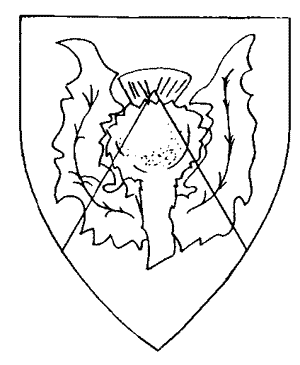 |
Per bend sable and Or a thistle counterchanged Or and vert. The submitter accepts minor changes and desires a feminine 7th century Angle name. She will allow a holding name. Cyneburh is cited from William George Searle, Onomasticon Anglo-Saxonicum, pg 154. Hartwood is an SCA branch name, registered in January of 1991. |
|
| 4. Dun an Chalaidh, Shire of | Device, Resubmission to Kingdom | |
 |
Per chevron azure and vert a chevron embattled between two laurel wreaths and a beacon argent enflamed gules. The branch name was registered in August of 2001. Their device, Per chevron argent and azure, twp laurel wreaths vert and a lighthouse argent enflamed proper, was returned by Laurel at the same time for conflict. This redesign addresses that issue. A petition is included which has a color rendition of the branch arms and is signed by eleven members of the populace including the Seneschal. |
|
| 5. Elisabeth Piper | Glymm Mere | Device, Change |
 |
Or, a unicorn couchant contourny purpure. The submitter's name was registered in October of 1983; her current device, Or a unicorn couchant purpure, overall a recorder palewise proper, was registered in November of 1980 and is to be released on registration of this change. |
|
| 6. Emma Le Blanc | Terra Pomaria | Name and Device, New |
 |
Quarterly vert and argent a cross purpure overall a sun in splendor Or. The submitter accepts minor changes, cares most about the meaning of the byname, 'the white', and desires a Norman feminine name. She will allow a holding name. Emma is from Talan Gywnek, "Feminine Given Names in A Dictionary of English Surnames" at http://www.s-gabriel.org/names/talan/reaney/reaney.cgi?Emma sub Emma, with dates spanning from 1130 thru 1507 (sub Bodley). Le Blanc is cited from Cateline de la Mor, "Sixteenth Century Norman Names", online at http://www.s-gabriel.org/names/cateline/norman16.html, where it is found in the exact submitted spelling, and from Dauzat's Dictionaire des Noms de Famille et Prenoms de France, sub Blanc as Leblanc, "surnom très frequent dans le nom de famille; avec article (surtout au Nord)." Blanc is cited from P.H. Reaney & R.M. Wilson, A Dictionary of English Surnames, sub Blanc: "Nigellus Blanke 1196 Cur (Lei); John Blaunk 1293 LLB C. OFr blanc 'white, fair'..." Copies of the webpages are included. |
|
| 7. Katherine Quhiting | Terra Pomaria | Name and Badge, New |
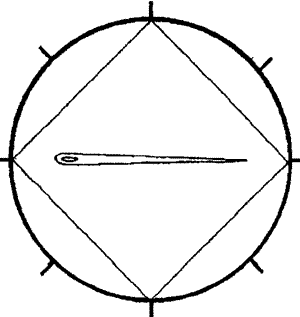 |
(Fieldless) Vert vêtu, a needle fesswise argent. The submitter accepts minor changes and desires a 14th century Scottish feminine name. She will allow a holding name. Katherine is cited from Talan Gywnek, "Feminine Given Names in A Dictionary of English Surnames", http://www.s-gabriel.org/names/talan/reaney/reaney.cgi?Katharine, '1316 Curzon, 1325xl, 1392 Bathurst, and E.G. Withycombe, The Oxford Dictionary of English Christian Names, pg 177-178. Quhiting is cited from George Black, The Surnames of Scotland, sub Whiting, "Quthiting (1400)." The badge is misblazoned and not really fieldless. |
|
| 8. Mairghread inghean Fhaolain | Blatha an Oir | Badge, Resubmission |
| (image missing from website -- see print version until I can fix this - Wenyeva.) | (Fieldless) A compass star per pale argent and azure. The submitter's name was registered in November of 2002. The previous submission, (Fieldless) A compass star per pale azure and argent, was returned from Kingdom in May of 2003 for conflict with Steffen le Stalkere: (Fieldless) A sun per pale azure and argent. |
|
| 9. Michael of Lancaster | Wealdsmere | Name and Device, New |
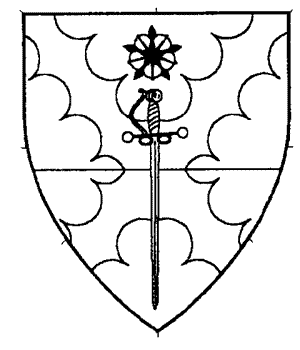 |
Per fess azure and argent, a saltire engrailed, counterchanged, a sword gules point to base, in chief a Lancastrian rose proper. The submitter will accept any changes and wishes a masculine name, possibly 15th century English (information from personal email with Lions Blood but not included on submission form). He will allow a holding name. Michael is a header spelling in E.G. Withycombe's The Oxford Dictionary of English Christian Names wherein the submitted spelling is shown dated 1096-1215, 1218, 1303, and 1346. Lancaster is a header spelling in P.H. Reaney & R.M. Wilson's A Dictionary of English Surnames with dated spellings being de Loncastre 1175 and de Lancastre 1327. The submitter will accept any period variant of the byname appropriate for the dated spellings of Michael, with or without preposition. The rose is entirely gules. |
|
| 10. Richard Touchet de la Croix | Lionsdale | Name and Device, Resubmission to Kingdom |
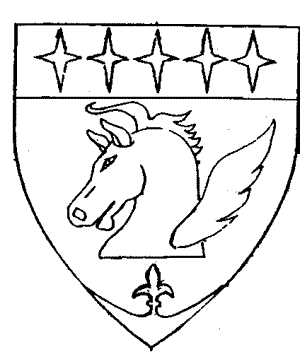 |
Sable, in chief or, 5 stars gules, In base pointed floretty or, Pegasus coupe dexter argent The submitter accepts minor changes and desires a 17th century masculine name. He will allow a holding name. His previously submitted name, Richard Touchet de Cathedrale Ste. Croix, was returned from Kingdom in June of 2002 for lack of any documentation; his previously submitted device, Sable, a Pegasus's head couped at the shoulder argent and a point pointed fleury at the point Or and on a chief gules five mullets of four points Or, was also returned from Kingdom in June of 2002 for both having a gules chief on a sable field, and for unidentifiability of the Pegasus's head as drawn, as it had wings issuing from just behind the ears. Richard is cited from http://www.tudorplace.com.ar/TOUCHET.htm: "Richard Touchet of Mackworth, b abt 1354". Touchet is also cited from http://web.ukonline.co.uk/Members/tom.paterson/touchet.htm, which dates the name from 1307 to 1595, ex. "James Touchet, Lord Audley, executed on 27 June 1497 at Tower Hill". Photocopies of both websites are included. No documentation is submitted for the element de la Croix. |
|
| 11. Steinn Vikingsson | Montengarde | Name and Device, New |
 |
Azure, a dolphin naiant embowed argent, in base an anchor Or. The submitter accepts changes, cares most about language/culture, and desires a masculine name. He will allow a holding name. Steinn is cited from Geirr Bassi Haraldsson, The Old Norse Name, pg 15, as meaning "stone". Víkingr is also cited from Geirr Bassi, pg 16. The submitter claims the correct patronymic form is Víkingsson. |
|
| 12. Svana Rauð¯x change from Serena of Blatha an Oir | Blatha an Oir | Name, Change of Holding Name |
|
The submitter accepts minor changes, cares most about the stated meaning of "Svana red ax", and desires a Norse feminine name. Her previous submission, Svana Mánagalinn, was returned from Laurel in May of 1996 for implausible construction of the byname. Svana is cited from Geirr Bassi Haraldsson, The Old Norse Name, pg 15 as a feminine personal name. Rauðøx is constructed from elements in Geirr Bassi. øx cited as 'ax' is found pg 20, e.g. blóðøx, 'blood ax', rauð cited as 'red' is found pg 26 eg rauðfeldr, 'red cloak', rauðskegger, 'red beard'. [Note from Lions Blood - the submitter dutifully enclosed a check to pay for her resubmission, as it has been many years since her name was returned. However, this is a change of holding name, as her armory was registered at the time her name was returned. According to the Administrative Handbook a change of holding name never requires payment. I have returned the lady's check, and though this is a bit of an obscure action am reminding all heralds to see what the Administrative Handbook says about submissions, when they cost (remembering that An Tir uses a one-year free resubmission process) and what all is required for a submission to be complete.] |
||
| 13. Tomas Alvarez | Borealis | Name and Device , New |
 |
Per pale gules and sable, domestic cat guardant rampant Or, sustaining a rapier argent. The submitter accepts any changes and desires a 16th century Spanish masculine name. He will allow a holding name. Tomas is cited from Collier's Encyclopedia, Volume 22, pg 372: "Torquemada, Tomás de, 1420-1498". Alvarez is cited from Collier's Encyclopedia, Volume 1, pg 618: "Alva, Fernando Alvarez de Toledo, Duke of, 1508-1582". Copies from the encyclopedia have been included. |
|
| 14. Valentino da Siena | Shittemwoode | Device, Resubmission to Laurel |
 |
Per pale sable and or three labels couped in pale counterchanged. The submitter's name was registered in March of 2003. The submitter's previous device of the same blazon was returned from Laurel on the same letter for an irreproducible arrangement of the labels, being neither in chief nor enhanced. The current rendition, filling the space well and using period artistic style, addresses that issue. |
|
In service,
Written by: |
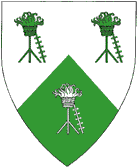
HTML by: |